Author: Kyle Moore
 I’m Kyle, I handle the outdoor content and gear recommendations, ensuring our blog stays top-notch. My mixed heritage enriches my love for diverse cultures and adventure. When I am not working, you will find me by the closest river or forest.
I’m Kyle, I handle the outdoor content and gear recommendations, ensuring our blog stays top-notch. My mixed heritage enriches my love for diverse cultures and adventure. When I am not working, you will find me by the closest river or forest.
Patagonia Puff Jackets vs Down Sweater
When it comes to choosing your puff jacket, there are a few things to consider. Fit, warmth, comfort, affordability and what you will be using your puffer for. Whether you are buying a puffer jacket for your hiking adventures or simply to keep warm during those harsh Winter months, here are some brilliant options to choose from. Additionally, for those who prefer vegan-friendly options, there are excellent synthetic alternatives available. One of our absolute favourite brands when we are outdoors is hands down Patagonia. Let’s take a closer look at 3 of their jackets to give you some better insight.
From Mountains to Main Street: The Story of Puff Jackets
Puff jackets, originally designed for mountaineers, have evolved significantly since their inception. To learn more about the transition to sustainable practices in outdoor clothing, check out our guide to Ethical Outdoor Clothing and Sustainable Gear. Early versions were bulky and limited in their functionality. Modern puff jackets, however, are engineered for a variety of conditions, utilising advanced materials and insulation technologies to provide maximum warmth without the weight. Brands such as Patagonia have led this innovation, combining eco-friendly materials with cutting-edge design to create jackets that are both functional and sustainable. We simply love the movement that is happening here to more sustainable production practices.
Micro Puff vs Nano Puff vs Down Sweater: Which One is Best for You?
Lightest and Most Packable
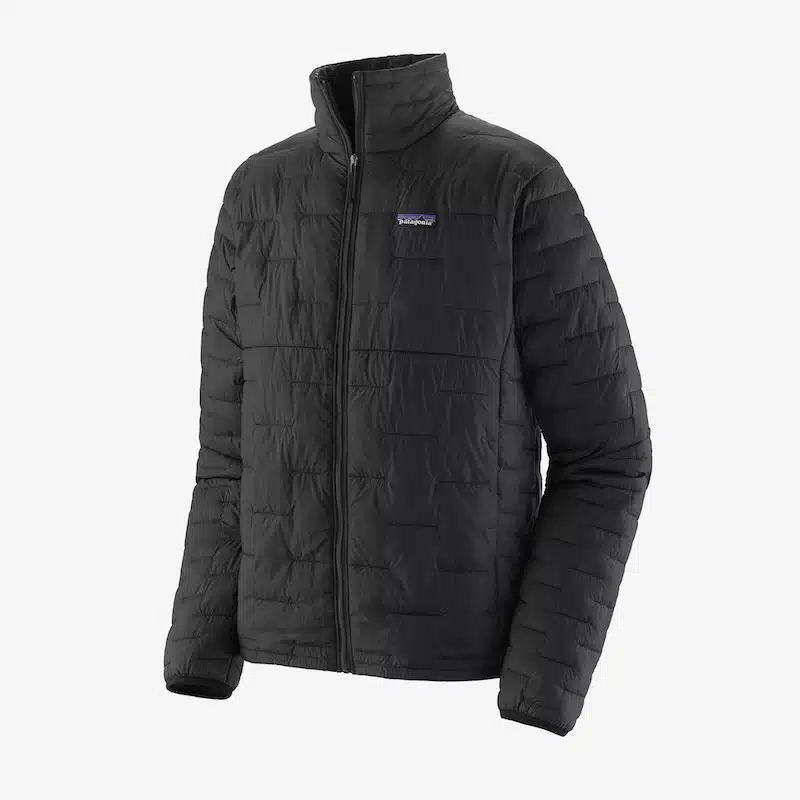
Patagonia Micro Puff
Most Versatile and Durable
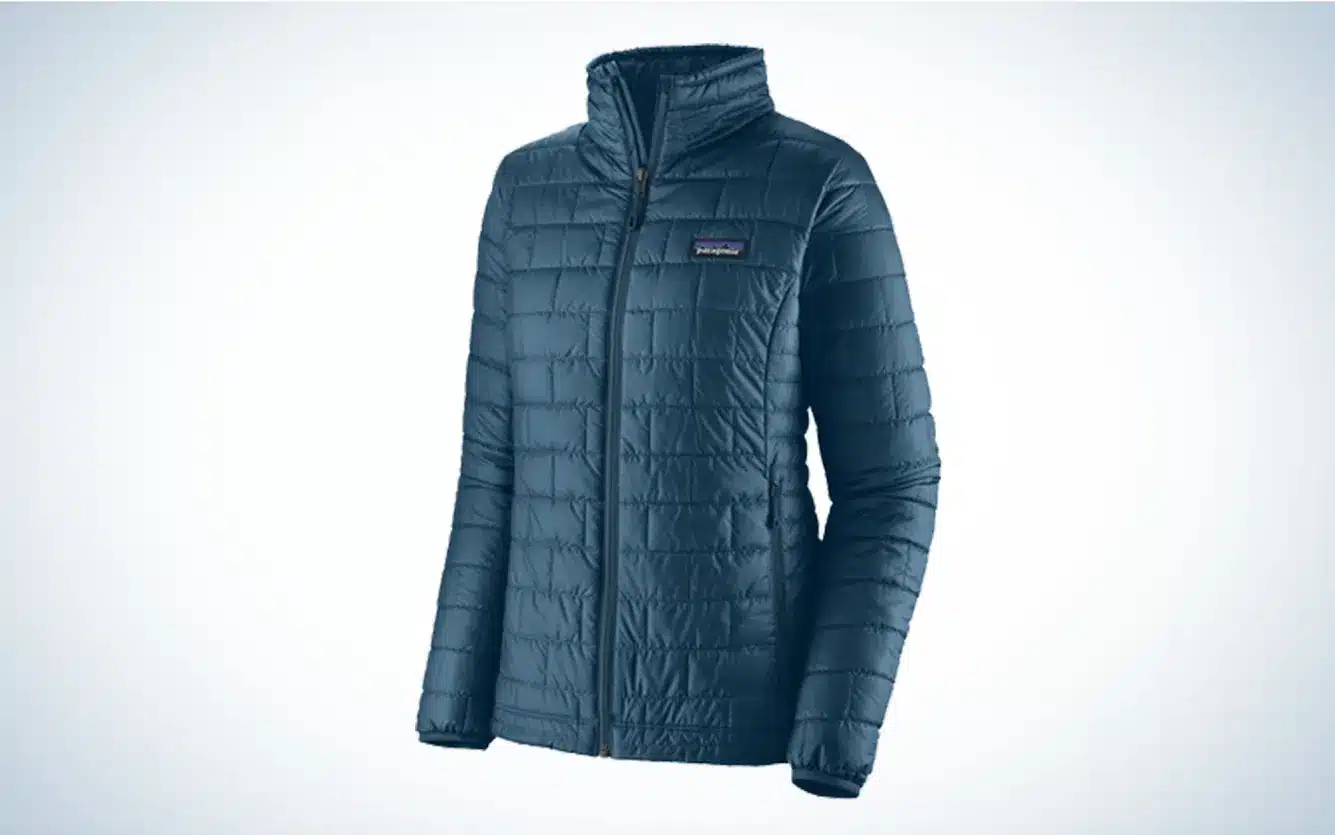
Patagonia Nano Puff
Best for Maximum Warmth
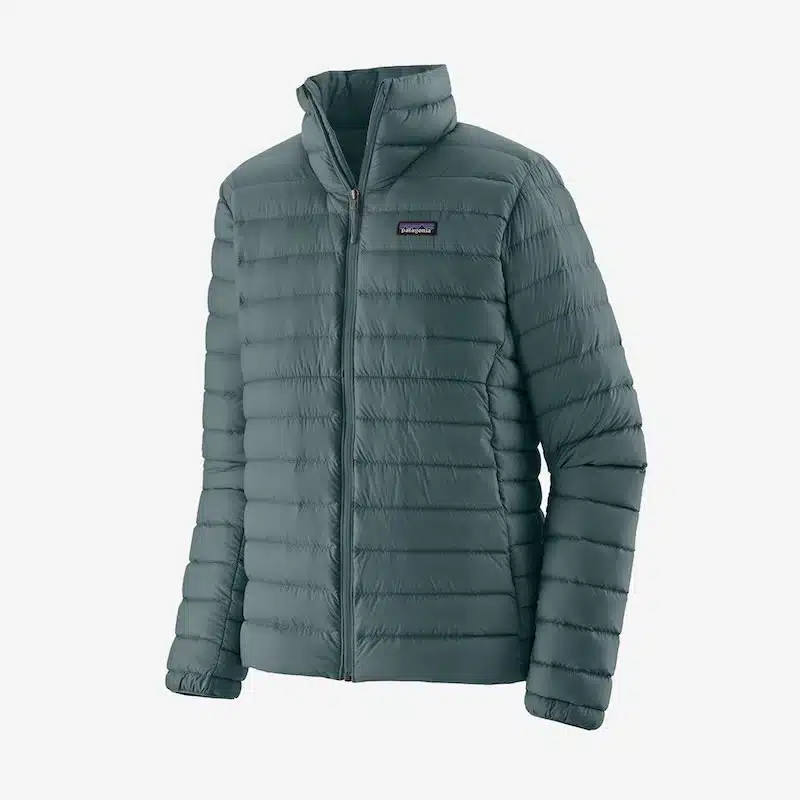
Patagonia Down Sweater
VV’s Patagonia Micro & Nano Puff vs Down Sweater Picks
- Best for lightweight backpacking and climbing: Patagonia Micro Puff
- Best for urban wear and outdoor activities: Patagonia Nano Puff
- Best for high-altitude hikes and winter activities: Patagonia Down Sweater
Best Patagonia Jackets: VV’s Top Picks for Micro Puff, Nano Puff, and Down Sweater
Each jacket in this collection has been carefully selected for its warmth, packability, and versatility, ensuring you stay comfortable in a variety of conditions. Our choices are informed by a number of sources, including personal use, recommendations from outdoor enthusiasts, and insights from gear experts. Our goal is to inspire and guide you in finding a jacket that perfectly matches your needs and adventures. Discover more ethical Patagonia gear in Our 10 Favourite Ethical Patagonia Winter Clothing Items.
1. Best Lightweight: Patagonia Micro Puff
The Patagonia Micro Puff excels in providing warmth relative to its weight, making it an excellent choice for lightweight backpacking and climbing. Its PlumaFill insulation mimics down, maintaining warmth even when wet, and it packs down incredibly small, which is ideal for space-saving. However, it’s less durable compared to the Nano Puff and has a higher price point.

Key Features
- Warmth-to-Weight Ratio: Excellent warmth with minimal weight, perfect for ultralight activities.
- Packability: Compresses into its own pocket, ideal for saving space.
- Durability: Lightweight fabric that’s less resistant to scrapes and scuffs.
- Weather Resistance: Moderate, with a durable water repellent finish (DWR).
- Versatility: Slim fit for layering under an outer shell.
Specifications
- Size
- Women’s XXS-XXL, Men’s XS-3XL
- Price
- $329
- Weight
- 8.9 ounces (men’s medium)
- Materials
- Pertex Quantum shell made of 100% postconsumer recycled nylon, PlumaFill insulation
- Pockets
- Two zippered handwarmer pockets and two internal drop-in pockets
VV Rating
Who Is It Good For
Ideal for lightweight backpacking, climbing, and activities needing minimal weight and maximum packability. Perfect for those who prioritize weight savings and need a jacket that packs down small without sacrificing warmth. Great for adventurers who often encounter wet conditions but still need insulation that performs well when damp.
What We Liked
- Incredibly lightweight and packable.
- Stays warm even when wet.
- High warmth-to-weight ratio.
What We Didn’t
- Less durable compared to thicker options.
- Higher price point.
Best Lightweight
2. Best Versatile: Patagonia Nano Puff
The Nano Puff offers a good balance of warmth, weight, and durability. It features PrimaLoft Gold Insulation Eco, which performs well even in wet conditions, and is more durable due to its thicker outer shell. It is versatile enough for both urban wear and outdoor activities.

Key Features
- Warmth-to-Weight Ratio: Provides sufficient warmth with moderate weight.
- Packability: Packs into its own pocket for convenience.
- Durability: More abrasion-resistant than the Micro Puff.
- Weather Resistance: Excellent in wet conditions with DWR finish.
- Versatility: Regular fit for easy layering and broad use cases.
Specifications
- Size
- Women’s XXS-XXL, Men’s XS-3XL
- Price
- $239
- Weight
- 11.9 ounces (men’s medium)
- Materials
- Pert100% recycled polyester ripstop with a PFC-free DWR finish, 60 grams PrimaLoft Gold Insulation Eco
- Pockets
- Two zippered handwarmer pockets and an internal zippered chest pocket that doubles as a stuff sack
VV Rating
Who Is It Good For
Ideal for versatile use, including wet conditions and casual wear. Suitable for urban environments and outdoor adventures alike, the Nano Puff is perfect for those who need a reliable, multi-functional jacket. Great for travelers and everyday users who want a jacket that performs well in a variety of settings and can handle regular outdoor use.
What We Liked
- Versatile and suitable for various activities.
- Maintains warmth when wet.
- Durable and abrasion-resistant.
What We Didn’t
- Slightly heavier than the Micro Puff.
- Not as warm as the Down Sweater.
Best Versatile
3. Best Warmth: Patagonia Down Sweater
The Down Sweater is the warmest option, utilizing 800-fill power down for superior insulation. It’s best suited for very cold and dry conditions but loses some insulating power when wet. Despite being bulkier, it is still packable and offers excellent warmth for its weight.

Key Features
- Warmth-to-Weight Ratio: Superior warmth with 800-fill power down.
- Packability: Packs into its own pocket, though bulkier than synthetic options.
- Durability: Highly durable with a tough ripstop shell.
- Weather Resistance: Moderate, with a durable water repellent finish (DWR).
- Versatility: Regular fit, suitable for layering
Specifications
- Size
- Women’s XXS-XXL, Men’s XS-3XL
- Price
- $279
- Weight
- 13.1 ounces (men’s medium)
- Materials
- 100% recycled polyester ripstop with a DWR finish, 800-fill-power Advanced Global Traceable Down
- Pockets
- Two zippered handwarmer pockets and an internal zippered chest pocket
VV Rating
Who Is It Good For
Ideal for high-altitude hikes and winter activities needing maximum warmth. Perfect for adventurers in extremely cold, dry conditions who prioritize warmth above all else. Great for mountaineers and winter campers who need reliable insulation for frigid temperatures and prefer the compressibility and loft of down insulation.
What We Liked
- Exceptional warmth with high-fill down.
- Durable construction.
- Packable despite being bulkier.
What We Didn’t
- Loses insulation efficiency when wet.
- Bulkier and heavier compared to synthetic options.
Best Warmth
Detailed Comparison
Warmth
Synthetic Insulation: Maintains warmth when wet, quick-drying, and hypoallergenic. Ideal for wet and unpredictable weather conditions.
Down Insulation: Offers a higher warmth-to-weight ratio and better compressibility, but loses insulating properties when wet and takes longer to dry.
Warmth by Jacket:
- Micro Puff: Great warmth-to-weight ratio with PlumaFill insulation, mimics down but stays warm when wet. Perfect for wet UK winters and summers.
- Nano Puff: Slightly less warm, but PrimaLoft Gold Eco insulation keeps you warm even when wet.
- Down Sweater: Warmest with 800-fill down, but loses insulation when wet, which can be an issue for those who get cold easily.
Weight and Packability
- Micro Puff: Lightest and most packable, perfect for those who need to save space and weight.
- Nano Puff: Heavier but still packs into its own pocket, easy to pack.
- Down Sweater: Heavier, yet provides excellent warmth-to-weight ratio, also packable into its pocket.
Weather Resistance
- Micro Puff: Good water resistance with synthetic insulation and durable water repellent (DWR) finish.
- Nano Puff: Best for wet conditions due to the synthetic insulation.
- Down Sweater: Decent water resistance with DWR, but less effective when the down gets wet. The down also takes longer to dry out as opposed to the synthetics.
Durability
Synthetic Insulation: Generally more durable in wet conditions and easier to care for as it can be machine washed and dried.
Down Insulation: Requires careful maintenance and is more susceptible to damage from moisture and compression over time.
Durability by Jacket:
- Micro Puff: Least durable because it’s so lightweight.
- Nano Puff: More durable, handles regular outdoor use well.
- Down Sweater: Most durable, tough ripstop shell for rough use.
Vegan-Friendly Alternatives to the Patagonia Down Sweater
For those seeking vegan-friendly alternatives to the Patagonia Down Sweater, there are excellent options available that provide similar warmth and durability without the use of animal products. The North Face ThermoBall Eco Jacket and Arc’teryx Atom LT Hoody are standout choices, offering synthetic insulation and sustainable materials. Explore the Best Vegan Insulated Jackets of 2024 for more choices
Why Choose Vegan-Friendly Jackets?
Choosing vegan-friendly jackets is not just about avoiding animal products; it’s also about making ethical and sustainable choices. Vegan jackets often use synthetic materials that are designed to provide warmth, durability, and water resistance without the use of down or other animal-derived materials. This can reduce the environmental impact and promote cruelty-free practices in the apparel industry.
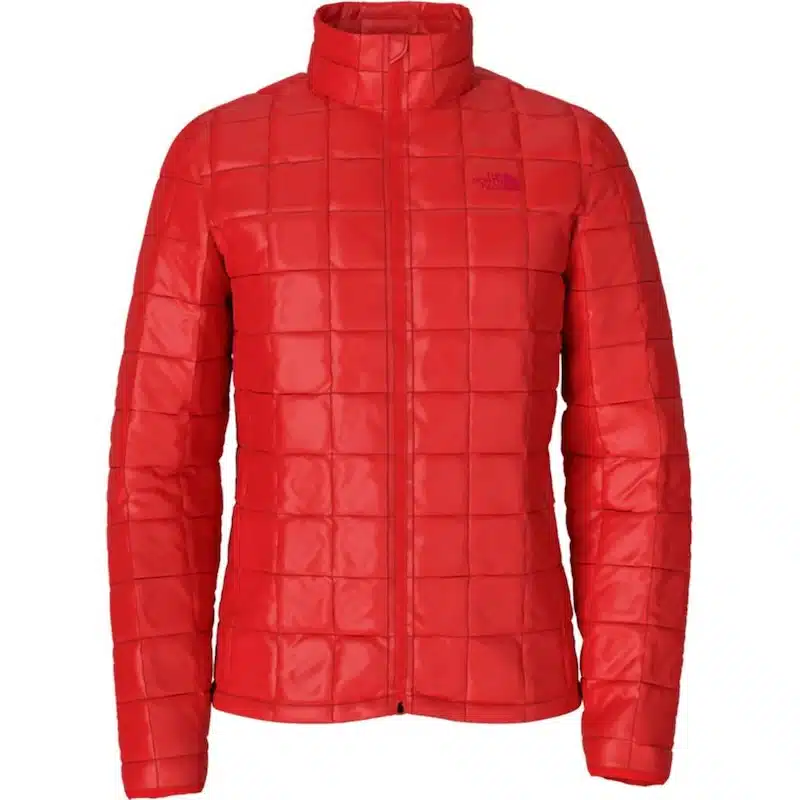
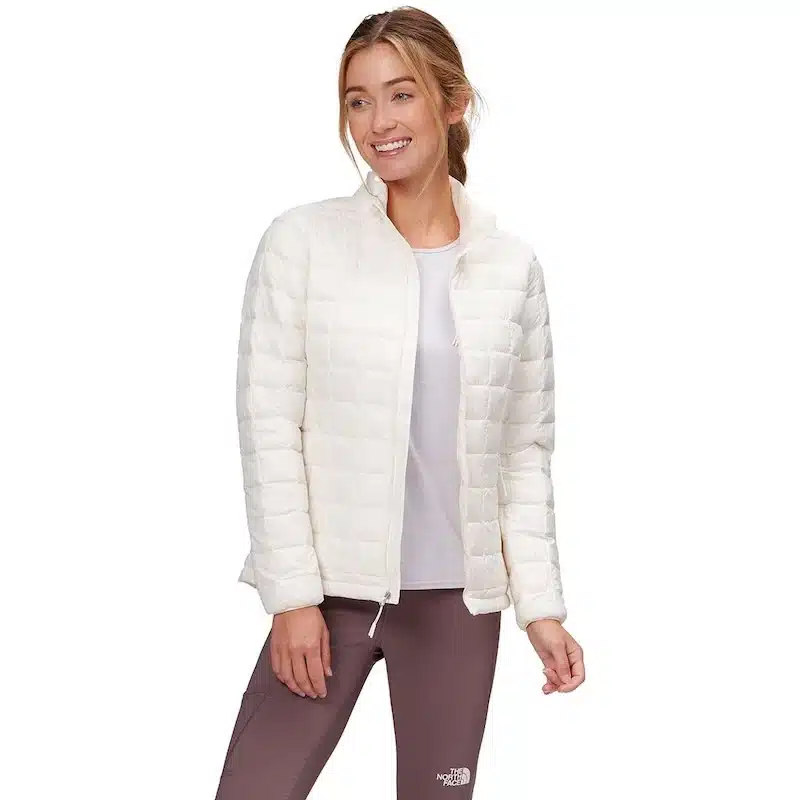
The North Face ThermoBall Eco Jacket
- Insulation: ThermoBall Eco insulation made from recycled polyester, mimics the feel of down but is entirely synthetic.
- Features: Lightweight, packable, and highly effective in wet conditions.
- Sustainability: Made from post-consumer recycled materials, promoting environmental responsibility
Specifications:
- Sizes: Available in men’s and women’s sizes ranging from XS to XXL.
- Weight: Approximately 15.9 ounces
- Pockets: Two zippered handwarmer pockets and an internal zippered chest pocket
If you liked the benefits of the Patagonia Nano Puff, the ThermoBall Eco Jacket by The North Face might be your next go-to. This jacket offers similar advantages but is crafted with a focus on sustainability and eco-friendliness.
Perfect for environmentally conscious consumers who prioritize sustainability without compromising on performance. Check out our full review on the The North Face Thermoball Hoodie
Check prices
The North Face ThermoBall Eco Jacket
For a detailed review of The North Face ThermoBall Eco Jacket, including its eco-friendly construction and performance in wet conditions, explore our full article. This jacket uses recycled materials and ThermoBall insulation to offer reliable warmth and packability, making it perfect for various outdoor adventures. Full Review Here

Arc’teryx Atom LT Hoody
- Warmth: Coreloft™ Compact insulation provides warmth even when wet and retains loft over time.
- Packability: Highly compressible, fitting into its own pocket or a small space in your pack.
- Durability: Tyono™ 20 face fabric is breathable and resistant to wear.
- Weather Resistance: DWR finish sheds light moisture.
- Breathability: Stretch fleece side panels enhance ventilation and temperature regulation during high-output activities.
Specifications:
- Sizes: Men’s and women’s XS to XXL
- Price: $260
- Weight: 14.6 ounces (men’s medium)
- Materials: Tyono™ 20 fabric with Coreloft™ Compact insulation
- Pockets: Two zippered handwarmer pockets, one internal zippered chest pocket
Ideal for climbers, hikers, and backcountry travelers needing a lightweight, packable jacket for varied conditions. It balances warmth, breathability, and durability, making it suitable as a midlayer or standalone piece. For more details, check out our full review Arc’teryx Atom LT Hoody Review. If you’re serious about outdoor adventures, don’t miss our roundup of the Best Arc’teryx Jackets
Check prices
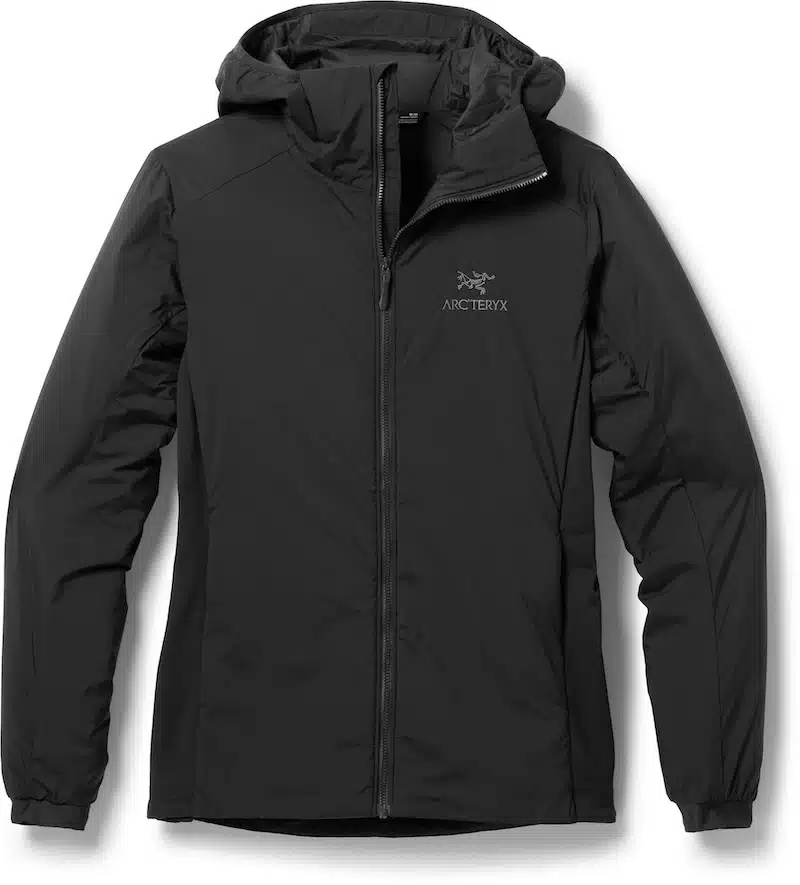
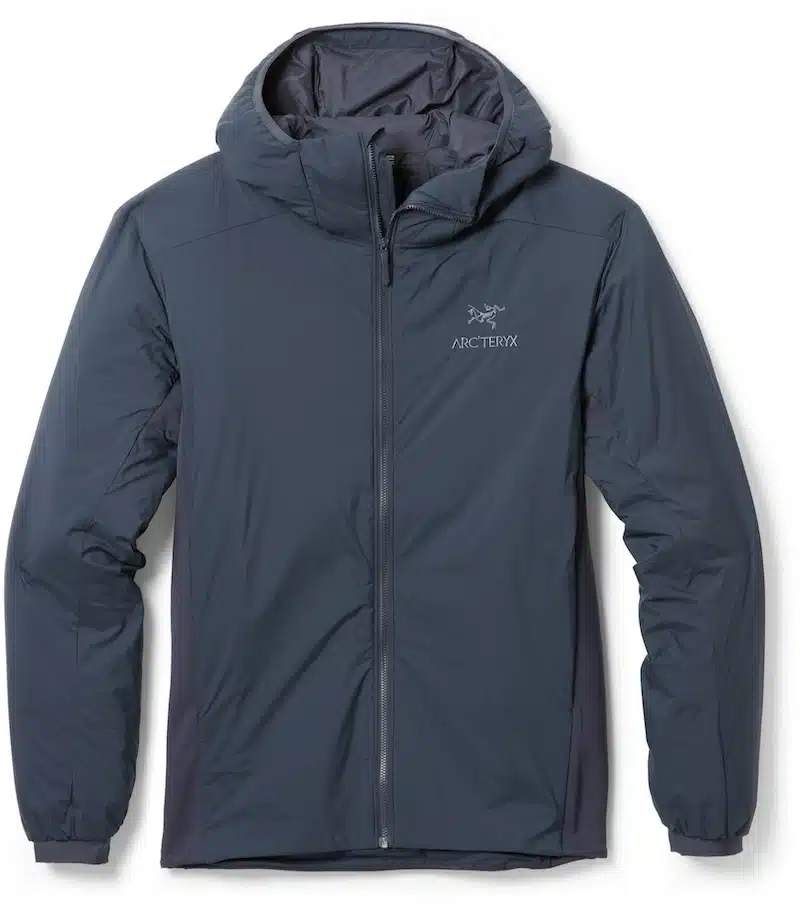
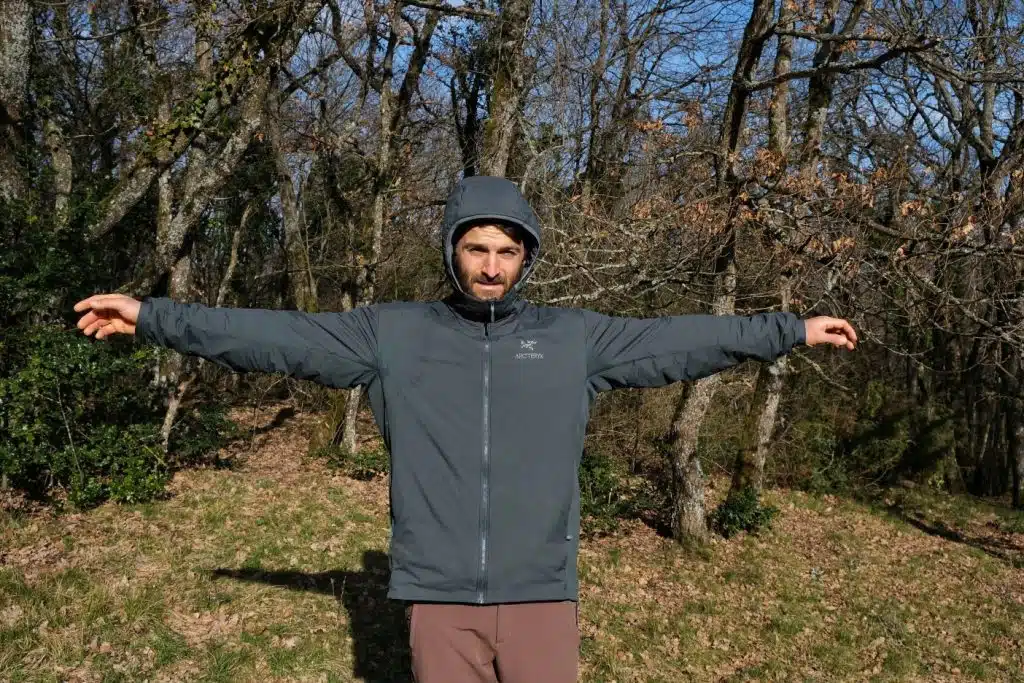
Arc’teryx Atom LT Hoody Review
For a comprehensive review of the Arc’teryx Atom LT Hoody, including its performance in varied conditions and suitability as both a midlayer and standalone piece, check out our detailed article. Ideal for climbers, hikers, and backcountry travelers, the Atom LT Hoody balances warmth, breathability, and durability. Read more here.
Synthetic vs. Down Insulation
Understanding the differences between synthetic and down insulation can help you make a more informed choice. Synthetic insulation, like that used in the Nano Puff and Micro Puff jackets, maintains its insulating properties when wet and dries quickly. In contrast, down insulation, while warmer and more compressible, loses its effectiveness when wet and takes longer to dry.
The Science Behind Synthetic Insulation
Synthetic insulation, such as PrimaLoft and PlumaFill, mimics the properties of down while offering superior performance in wet conditions as they dry far quicker. These materials trap heat efficiently, ensuring you stay warm even when the jacket gets damp. Unlike traditional down, synthetic fibres maintain their loft and insulation capabilities when wet, making them ideal for unpredictable weather conditions. This technology has revolutionized outdoor apparel, providing adventurers with reliable warmth and comfort in a lightweight package.
Recommendations For Activity
Hiking and Backpacking
- Micro Puff: Ideal for long hikes and backpacking trips due to its lightweight and packable design. Provides sufficient warmth during early morning starts and cool evenings.
- Nano Puff: Versatile for various hiking conditions, especially where rain or snow might be encountered. Dries quickly and maintains warmth when wet, perfect for multi-day hikes.
- Down Sweater: Best for high-altitude hikes or colder climates where maximum warmth is essential. It’s bulkier but offers superior insulation for extreme cold.
Climbing
- Micro Puff: Excellent for climbers who need to minimize weight without sacrificing warmth. The slim fit and packability make it easy to carry and wear under a climbing harness.
- Nano Puff: Suitable for a range of climbing activities, especially in damp conditions. The durable construction withstands the abrasions from rock faces.
- Down Sweater: Recommended for cold, dry conditions often found in alpine climbing. Its durability and warmth make it a reliable choice for high-altitude adventures.
Casual Wear and Urban Use
- Micro Puff: Lightweight and stylish, suitable for everyday use in cool climates. Its sleek design pairs well for everyday use in cool climates. Its sleek design pairs well with casual attire.
- Nano Puff: The most versatile option, transitioning seamlessly from outdoor adventures to urban environments. Its quick-drying feature is beneficial for unpredictable weather.
- Down Sweater: Ideal for very cold urban environments where maximum warmth is needed. Offers a classic look with substantial insulation.
For those engaging in high-intensity activities such trail running like my wife, or fast-paced hiking, the Micro Puff jacket offers the perfect balance of lightweight warmth and breathability, ensuring you don’t overheat while on the move. Its compact design makes it easy to stow away when not needed.
In wetter environments or where sudden weather changes are common, the Nano Puff stands out with its excellent water resistance and quick-drying capabilities. It’s particularly suited for coastal hikes, rainforest treks, or urban commutes where you might get caught in the rain.
For extreme cold environments, such as winter camping or high-altitude expeditions, the Down Sweater provides unparalleled warmth. Its high-fill power down insulation ensures that even the harshest temperatures are manageable, making it the go-to choice for mountaineers and cold-weather adventurers. For an alternative, consider the Patagonia Better Sweater Jacket Review.
For essential winter clothing, see our guide on vegan winter hiking gear and cold weather layering.
Puff Jackets for Males and Females:
Micro Puff
- Men’s Hoody: Full-zip with helmet-compatible hood
https://www.backcountry.com/patagonia-micro-puff-hooded-insulated-jacket-mens - Women’s Hoody: Full-zip with helmet-compatible hood
https://www.backcountry.com/patagonia-micro-puff-hooded-insulated-jacket-womens - Men’s Jacket: Full-zip without hood, slim fit
https://www.backcountry.com/patagonia-micro-puff-insulated-jacket-mens - Women’s Jacket: Full-zip without hood, slim fit
https://www.backcountry.com/patagonia-micro-puff-insulated-jacket-womens
Nano Puff
- Men’s Hoody: Full-zip with hood
https://www.backcountry.com/patagonia-nano-puff-hooded-insulated-jacket-mens - Women’s Hoody: Full-zip with hood
https://www.backcountry.com/patagonia-nano-puff-hooded-insulated-jacket-womens - Men’s Jacket: Full-zip without hood
https://www.backcountry.com/patagonia-nano-puff-insulated-jacket-mens - Women’s Jacket: Full-zip without hood
https://www.backcountry.com/patagonia-nano-puff-insulated-jacket-womens - Men’s Vest: Sleeveless option for core warmth
https://www.backcountry.com/patagonia-nano-puff-vest-mens - Women’s Vest: Sleeveless option for core warmth
https://www.backcountry.com/patagonia-nano-puff-vest-womens
Down Sweater
- Men’s Hoody: Full-zip with hood
https://www.backcountry.com/patagonia-down-sweater-hooded-jacket-mens - Women’s Hoody: Full-zip with hood
https://www.backcountry.com/patagonia-down-sweater-hooded-jacket-womens - Men’s Jacket: Full-zip without hood
https://www.backcountry.com/patagonia-down-sweater-jacket-mens - Women’s Jacket: Full-zip without hood
https://www.backcountry.com/patagonia-down-sweater-jacket-womens - Men’s Vest: Sleeveless option for core warmth
https://www.backcountry.com/patagonia-down-sweater-vest-mens - Women’s Vest: Sleeveless option for core warmth
https://www.backcountry.com/patagonia-down-sweater-vest-womens
All of the above options are versatile, fit well, and provide you with options, a personal favourite point for my wife, who let’s face it would buy each of them in every colour and option if I looked away for a second! ☺
What Others Are Saying
Many people love the Patagonia Micro Puff for its amazing lightness and packability, making it a top pick for minimalist backpackers and climbers. It is able to keep you warm during some tough trails.
On the flip side, the Nano Puff gets high marks for its versatility and performance in wet conditions, as it stays warm even when wet.
For those seeking maximum warmth, the Down Sweater is often the preferred choice for Winter camping trips and keeping you warm at night.
My Thoughts
Deciding between the Patagonia Micro Puff, Nano Puff, and Down Sweater comes down to your specific needs and the conditions you’ll encounter. The Micro Puff shines with its lightweight and packable design, ideal for those looking to cut down on weight. The Nano Puff is versatile and performs well in wet conditions, while the Down Sweater offers maximum warmth in dry settings. Each jacket has its unique strengths, so think about your typical activities and environments to make the best choice for your adventures.
“Remember to Embrace the outdoors, where life is lived and loved to the fullest.”
Written By: Kyle Moore

Hi, I’m Kyle! I handle the outdoor content and gear recommendations for our blog, making sure it’s always top-notch. When I’m not working, you’ll probably find me by a river, hiking in the forest, cycling around town and nature, or enjoying a good audiobook.
Fun fact: My family’s a mix of Welsh and South African!




